This is the third part of a series of posts analyzing the swing state Pennsylvania. Part four can be found here.
Philadelphia’s Suburbs
There used to be a time when Republicans could count on Philadelphia’s suburbs to counter Democratic margins from the city. This is Philadelphia, circa 1988:
Not anymore. Philadelphia, 2008:
(Note: Because the Times stopped updating before all absentee/provisional ballots were counted, this map does not fully reflect the actual results. I have corrected the discrepancy.)
Indeed, in 2008 President Barack Obama’s suburban margins were so great that Democrats did not even need Philadelphia to win Pennsylvania.
Philadelphia’s suburbs stretch across four counties: Bucks, Chester, Delaware, and Montgomery. Bucks contains more working-class, Catholic communities. Chester, on the other hand, is more exurban and conservative (in this century, Democrats have only incontrovertibly won the county twice – in 1964 and 2008).
More below.
The suburbs hold more importance than implied by the above maps, which tend to exaggerate Philadelphia’s size due to its one-sided voting pattern. While the city’s population continues its long, slow decline, its suburbs have grown at a rapid clip. Today, the number of votes they hold almost doubles the city’s reservoir.
While regional differences exist, Philly’s suburbs do have one thing in common: they compose the wealthiest area in the entire state. Chester, Bucks, and Montgomery Counties rank #1, #2, and #3 in the state’s median household income. They also lack diversity; the census classifies around 90% of Bucks County residents as non-Hispanic whites.
Given these characteristics, one might expect Philly’s suburbs to be rock-hard Republican strongholds. Until recently they did vote strongly Republican; Democrats only won the suburbs twice (in 1964 and – due to TR’s Bull Moose candidacy – 1912) before 1992. It was President Bill Clinton who changed this pattern; in 1992 he barely managed to turn Bucks, Delaware, and Montegomery blue (his greatest margin was 3.4%). Ever since then Democrats have been doing better and better.
This shift does not constitute an anomaly; Democratic candidates since Mr. Clinton have been winning a number of wealthy, white suburban counties that used to go strongly Republican. Before Clinton, Long Island and Westchester consistently gave Republicans double-digit margins; today they’ve voted Democratic for the past four consecutive elections. Detroit’s suburbs – Oakland and Macomb counties – have gone from Reagan Democrat fortresses to regions John Kerry tied. Senator John McCain barely won Orange County, that symbol of suburban Republican might.
Montgomery and Delaware counties are especially Democratic-friendly. They identify more with the populous, sophisticated northeastern seaboard than the more conservative Midwest. As such, these counties by nature sympathize with liberal sentiment; George W. Bush lost both by double-digits. This does not necessary mean, however, that Montgomery and Delaware constitute bastions of acceptance; products of white flight from Philadelphia, they can at times be fairly hostile to people who are considered different.
Increasing Democratic strength in these well-off suburbs portends great trouble for Republicans. In 2008, Mr. Obama’s performance in Montgomery and Delaware counties eclipsed his suburban strength in practically every other swing state. Only suburbs in places like the Bay Area, Seattle, and New England voted more Democratic.
In total, Obama won the Philly suburbs by 15.56%. Combined with his landslide in the city itself, he came out of southeast Pennsylvania with a 682,392 vote margin. This meant that John McCain needed to win the rest of the state by 58.79%.
If Pennsylvania was like Missouri – if the remainder of the state voted strongly Republican – this might just have been possible. But Pennsylvania is not like Missouri; southwestern Pennsylvania used to be unchallenged Democratic territory, while Scranton, Erie, and the Lehigh Valley all lean Democratic. John McCain thus lost the state by double-digits. His only successes occurred in southwestern Pennsylvania, which is reddening almost as quickly as the southeast is bluing.
–Inoljt, http://mypolitikal.com/
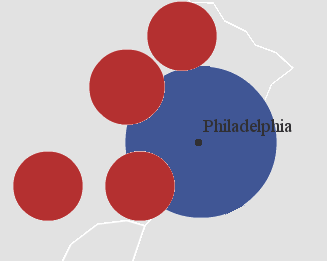
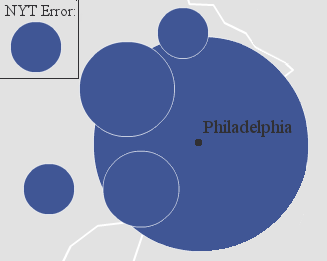
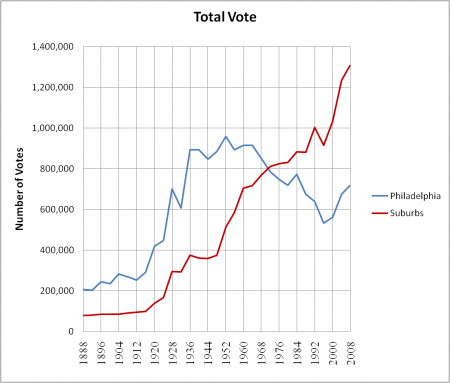
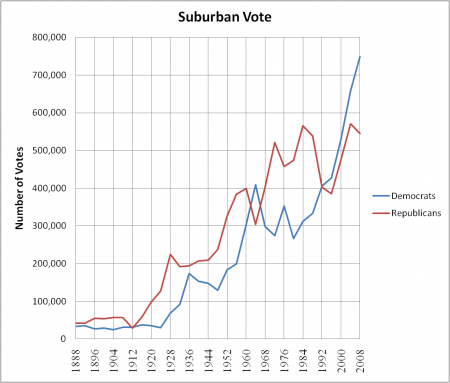
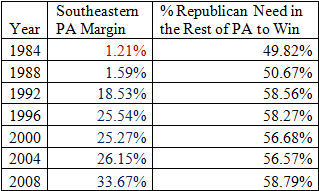
1964 and 2008 were the only years that a Democratic Presidential candidate carried Chester County. Ed Rendell and Bob Casey Jr. handily carried it in 2006 and Obama actually did slightly better there than in Bucks. Montgomery and Delaware went for Obama by over 20% and Bucks and Chester went around 9% for him. This article neglects to mention that Democrats captured the registration edge in Bucks and Montgomery Counties in the spring of 2008 and that Republicans no longer constitute an absolute majority of voters in Chester and Delaware. If Obama wins re-election in 2012, he carries all four counties again.